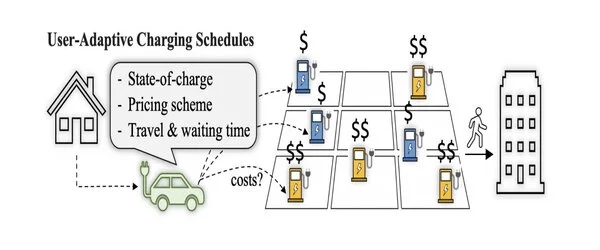To reduce transportation emissions, cities must promote walking, cycling, and public transportation, as well as electrify the vehicles that remain on their roads: bus fleets, municipal vehicles, commercial fleets, and private vehicles.
North Carolina State University researchers have created a dynamic computational tool to aid in improving user access to electric vehicle (EV) charging stations, with the goal of making EVs more appealing to drivers.
“We already know that there is a need for EV charging networks that are flexible, in order to support the adoption of EVs,” says Leila Hajibabai, corresponding author of a paper on the work and an assistant professor in NC State’s Fitts Department of Industrial and Systems Engineering. “That’s because there is tremendous variability in when and where people want to charge their vehicles, how much time they can spend at a charging station, how long it takes to charge their vehicles, and so on.
“The fundamental question we wanted to address with this work is: What is the best way to manage existing charging station infrastructure in order to best meet the demands of electric vehicle users?”
We already know that there is a need for EV charging networks that are flexible, in order to support the adoption of EVs. That’s because there is tremendous variability in when and where people want to charge their vehicles, how much time they can spend at a charging station, how long it takes to charge their vehicles, and so on.
Leila Hajibabai
The researchers wanted to answer that question from the perspective of the user, so they focused on questions that are important to EV drivers. How much time will it take me to get to a charging station? How much does it cost to use the charging station? How long will I have to wait for a charging station? And what kind of penalties will I face if I stay at a charging station past the time limit?
The researchers devised a method for accounting for all of these factors in a complex computational model based on a game theory framework.
The technique accomplishes two goals. First, it assists users in locating the nearest charging station that meets their requirements. Second, it has a dynamic system that charging station operators can use to determine how long vehicles can spend at a charging station before they need to make way for the next vehicle.

“These outcomes are themselves dynamic – they evolve as additional data comes in about how users are making use of charging facilities,” Hajibabai says.
For example, depending on whether any spaces are available, a user’s nearest available charging facility may change. Furthermore, the amount of time users can spend at a charging station may vary from day to day to reflect how people use different charging facilities.
In 2020, there will be ten million electric cars on the road worldwide. It was a watershed moment in the electrification of mass transportation. Electric car sales accounted for 4.6% of total global car sales. The range of electric vehicle models has grown. New battery technology initiatives have been launched.
“There is no clear real-world benchmark that we can use to assess the extent to which our technique would improve user access to charging facilities,” Hajibabai says. “However, in simulations, the technique did improve user access. The simulations also show that flexibility in when charging station slots are available is a key predictor of which stations users will visit. The next step would be to collaborate with existing charging station networks to pilot the technique and evaluate its performance in a real-world setting.”
















